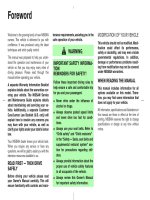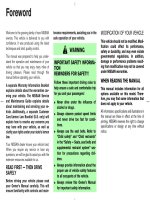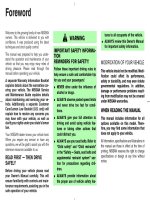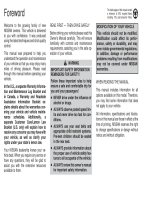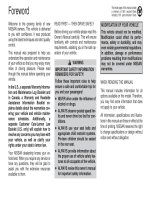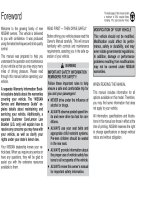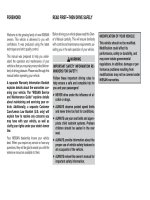NISSAN PATHFINDER 1996 OWNER MANUAL - SÁCH HƯỚNG DẪN SỬ DỤNG XE NISSAN PATHFINDER ĐỜI 1996
Bạn đang xem bản rút gọn của tài liệu. Xem và tải ngay bản đầy đủ của tài liệu tại đây (1.71 MB, 223 trang )
Foreword
Welcome to the growing family of new NISSAN owners. This vehicle has been delivered to you with confidence. Your vehicle has been produced
using the latest techniques and strict quality control.
This manual has been prepared to help you understand the operation and maintenance of your vehicle so that you may enjoy many miles of driving
pleasure. Please read through this manual before operating your vehicle.
A separate “Warranty Information” explains details about the warranties covering your vehicle.
Remember that your NISSAN dealer knows your vehicle best. When you require any service or have any questions about your vehicle, he will be
glad to assist you with the extensive resources available to him.
IMPORTANT SAFETY INFORMATION
REMINDERS FOR SAFETY!
Follow these five important driving rules to help ensure a safe and
complete trip for you and your passengers!
¼ NEVER drive under the influence of alcohol or drugs.
¼ ALWAYS observe posted speed limits and never drive too fast
for conditions.
¼ ALWAYS use your seat belts and appropriate child restraint
systems.
¼ ALWAYS provide information about the proper use of vehicle
safety features to all occupants of the vehicle.
¼ ALWAYS review this Owner’s Manual for important safety
information.
NOTES ON THE INFORMATION CONTAINED IN THIS
OWNER’S MANUAL
This owner’s manual contains descriptions and operating instruc-
tions for all systems, features and optional equipment that might
appear in any model of this vehicle built for any destination in
North America, including the continental United States, Canada
and Hawaii. Therefore, you may very well find information in this
manual that does not apply to your vehicle.
For descriptions specified for 4-wheel drive models, a
mark is
placed at the beginning of the applicable sections/items.
੬ 01.2.1/R50-D ੭
ON-PAVEMENT AND OFF-ROAD DRIVING
This vehicle will handle and maneuver differently from an ordinary
passenger car, because it has a higher center of gravity for off-road use.
As with other vehicles with features of this type, failure to operate this
vehicle correctly may result in loss of control or an accident.
Be sure to read “On-Pavement and Off-Road driving precautions” and
“Avoiding collision and rollover” in the “Starting and driving” section of
this manual.
MODIFICATION OF YOUR VEHICLE
This vehicle should not be modified. Modification could affect its
performance, safety or durability, and may even violate governmental
regulations. In addition, damage or performance problems resulting
from modification may not be covered under NISSAN warranties.
All information, specifications and illustrations in this manual are those
in effect at the time of printing. NISSAN reserves the right to change
specifications or design without notice and without obligation.
© 1995 NISSAN MOTOR CO., LTD.
TOKYO, JAPAN
੬ 01.2.1/R50-D ੭
Welcome To The World Of NISSAN
Your new Nissan is the result of our dedication to
produce the finest in safe, reliable and economi-
cal transportation. Your vehicle is the product of
a successful worldwide company that manufac-
tures cars and trucks in over 17 countries and
distributes them in 170 countries.
Nissan vehicles are designed and manufactured
by Nissan Motor Co., Ltd. which was founded in
Tokyo, Japan in 1933, and Nissan affiliates world
wide, collectively growing to become the fifth
largest automaker in the world. In addition to cars
and trucks, Nissan also makes textile machinery,
fork-lift trucks, marine engines, boats and other
products.
Nissan has made a substantial and growing
investment in North America, starting with the
opening of Nissan Motor Corporation U.S.A. in
1960 and continuing with the production of some
cars and trucks at one of the world’s most
modern manufacturing facilities, Nissan Motor
Manufacturing Corporation U.S.A. in Smyrna,
Tennessee, vehicle styling at Nissan Design
International in San Diego, California, and engi-
neering at Nissan Research and Development in
Farmington Hills, Michigan.
Nissan Motor Corporation U.S.A. and its dealers
indirectly employ about 60,000 Americans.
Nissan is also a substantial contributor to the
Canadian economy. Nissan Canada Inc., its sup-
pliers and over 170 dealers employ approxi-
mately 4,500 people. These include company
employees and the staffs of Nissan dealers all
across Canada. In addition, many Canadians
work for companies that supply Nissan and Nis-
san dealers with materials and services ranging
from operation of port facilities and transportation
services, to the supply of lubricants, parts and
accessories.
Nissan pioneered the use of electronics and
computers in automobiles, and has led the indus-
try in improving both performance and fuel effi-
ciency through new engine designs and the use
of synthetic materials to reduce vehicle weight.
The company has also developed ways to build
quality into its vehicles at each stage of the
production process, both through extensive use
of automation and — most importantly —
through an awareness that people are the cen-
tral element in quality control.
From the time the parts arrived from our suppli-
ers until you took delivery of your new Nissan,
dozens of checks were made to ensure that only
the best job was being done in producing and
delivering your vehicle. Nissan also takes great
care to ensure that when you take your Nissan to
your dealer for maintenance, the service techni-
cian will perform his work according to the quality
standards that have been established by the
factory.
Safety has also been built into your Nissan. As
you know, seat belts are an integral part of the
safety systems that will help protect you and your
passengers in the event of a sudden stop or an
accident. We urge you to use the belts every time
you drive the vehicle.
The Nissan story of growth and achievement
reflects our major goal: to provide you, our
customer, with a vehicle that is built with quality
and craftsmanship — a product that we can be
proud to build and you can be proud to own.
AFW0001
੬ 01.2.1/R50-D ੭
NISSAN CUSTOMER CARE PROGRAM
NISSAN CARES
Both NISSAN and your NISSAN dealer are dedicated to serving all your automotive needs. Your satisfaction with your
vehicle and your NISSAN dealer are our primary concerns. Your NISSAN dealer is always available to assist you with all
your automobile sales and service needs.
However, if there is something that your NISSAN dealer
can not assist you with or you would like to provide
NISSAN directly with comments or questions, please
contact our (NISSAN’s) Consumer Affairs Department
using our toll-free number:
For U.S. mainland customers
1-800-NISSAN-1 (1-800-647-7261)
For Hawaii customers
(808) 531-0231 (Oahu Number)
For Canada customers
1-800-387-0122
The Consumer Affairs Department will ask for the following information:
— Your name, address, and telephone number
— Vehicle identification number (on dashboard)
— Date of purchase
— Current odometer reading
— Your NISSAN dealer’s name
— Your comments or questions
You can write to NISSAN with the information on the left
at:
For U.S. mainland and Alaska customers
Nissan Motor Corporation U.S.A.
Consumer Affairs Department
P.O. Box 191
Gardena, California 90247
For Hawaii customers
Nissan Motor Corporation in Hawaii
2880 Kilihau St.
Honolulu, Hawaii 96819
For Canada customers
Nissan Canada Inc.
P.O. Box 1709, Station “B”
Mississauga, Ontario L4Y 4H6
OR
We appreciate your interest in NISSAN and thank you for buying a quality NISSAN vehicle.
੬ 01.2.1/R50-D ੭
Contents
Instruments and controls
Pre-driving checks and adjustments
Heater, air conditioner and audio system
Starting and driving
In case of emergency
Appearance and interior care
Do-it-yourself operations
Maintenance schedule
Technical information
Index
੬ 01.2.1/R50-D ੭
1 Instruments and controls
Meters and gauges 1-3
Speedometer and odometer 1-3
Tachometer 1-4
Engine coolant temperature gauge 1-4
Fuel gauge 1-5
Compass and outside temperature display
(If so equipped) 1-5
Clock 1-8
Warning/indicator light and buzzer 1-9
Theft warning (If so equipped) 1-13
Headlight and turn signal switch 1-15
Windshield wiper and washer switch 1-16
Rear window wiper and washer switch 1-17
Rear window defogger switch 1-18
Instrument brightness control 1-18
Front fog light switch 1-19
Hazard warning flasher switch 1-19
Heated seat (If so equipped) 1-20
Cigarette lighter and ash trays 1-21
Power socket 1-22
Coin tray 1-22
Cup holder 1-23
Glasses case 1-23
Console box 1-24
Luggage board and box 1-25
Tonneau cover 1-26
Power window 1-26
Sunroof 1-28
Interior light 1-29
Spot light 1-30
Inspection light 1-30
Vanity mirror light 1-30
Adjustable shock absorber control
(If so equipped) 1-31
Integrated HomeLink
TM
transmitter
(If so equipped) 1-31
੬ 01.2.1/R50-D ੭
Driver’s supplemental air bag (P.2-18)
Cruise control
set switch
(P.4-13)
Outside mirror remote control
(P.2-37)
Headlight/dimmer/turn signal switch (P.1-15)
Front fog light switch (P.1-19)
Meter/gauge (P.1-3)
Windshield wiper/washer switch (P.1-16)
Hazard warning flasher switch (P.1-19)
Center ventilator (P.3-2)
Heater/air conditioner control (P.3-3)
Compass/outside air temperature display (P.1-5)
Passenger supplemental air bag (P.2-18)
Side ventilator (P.3-2)
Glove box (P.2-10)
Cigarette lighter (P.1-21)
Radio/CD player (P.3-14)/clock (P.1-8)
Adjustable shock absorber control switch (P.1-31)
Rear window wiper/washer switch (P.1-17)
Rear window/outside mirror defogger switch (P.1-18)
Ignition switch/steering lock (P.4-4)
Heated seat switch (P.1-20)
Tilting steering wheel adjust lever (P.2-36)
Hood release lever (P.2-9)
Fuse box cover (P.7-21)
Coin tray (P.1-22)
Theft warning light (P.1-13)
Cruise control main switch (P.4-13)
Instrument brightness control
(P.1-18)
SIC0585
See the page indicated in parentheses for operating details.
1-2
੬ 01.2.1/R50-D ੭
Speedometer
The speedometer indicates vehicle speed.
Odometer
The odometer records the total distance the
vehicle has been driven.
Trip odometer
The trip odometer records the distance of
individual trips. Before each trip, set the trip
odometer to zero by pushing the RESET knob.
SIC0586
SIC0587
METERS AND GAUGES SPEEDOMETER AND ODOMETER
1-3
੬ 01.2.1/R50-D ੭
The tachometer indicates engine speed in
revolutions per minute (r/min).
When engine speed approaches the red
zone, shift to a higher gear. Operating
the engine in the red zone may cause
serious engine damage.
The gauge indicates the coolant temperature.
The coolant temperature will vary with the
outside air temperature and driving conditions.
If the gauge indicates over the normal
range, stop the vehicle as soon as safely
possible. If the engine is overheated,
continued operation of the vehicle may
seriously damage the engine. See “In
case of emergency” section for immedi-
ate action required.
SIC0588 SIC0545
TACHOMETER
ENGINE COOLANT
TEMPERATURE GAUGE
1-4
੬ 01.2.1/R50-D ੭
The gauge indicates the APPROXIMATE fuel
level in the tank.
The gauge may move slightly during braking,
turning, acceleration, or going up or down hill.
The gauge needle is designed to remain in
approximately the same position, even when
the ignition key is turned “OFF”.
Refill the fuel tank before the gauge regis-
ters Empty.
This unit is a display unit which possesses the
following functions:
¼ Function to measure terrestrial magnetism
and indicate heading direction of vehicle
¼ Function to indicate outside air temperature
¼ Function to indicate caution for frozen road
surfaces
Outside temperature display
Push the switch when the ignition key is in the
“ACC” or “ON” position. The outside tempera-
ture will be displayed in “°F”.
¼ Selecting the indication range
Push the switch to change from “°F” to “°C”.
¼ If the outside temperature drops below the
freezing point, the display indicates
ICE .
SIC0546 SIC0590 SIC0610
FUEL GAUGE
COMPASS AND OUTSIDE
TEMPERATURE DISPLAY
(If so equipped)
1-5
੬ 01.2.1/R50-D ੭
¼ The outside temperature sensor is
installed in the front of the radiator.
The display may not indicate the cor-
rect temperature due to the heat of
the road and engine depending on
the direction of the wind and driving
conditions, etc.
¼ Use the “ICE” indication for reference
only. Confirm the traffic information
and road conditions to drive safely.
¼ When the outside temperature is be-
tween 130°F (55°C) and 158°F (70°C),
the display shows 130°F (55°C).
¼ When the outside temperature is
lower than −20°F (−30°C) or higher
than 158°F (70°C), the display shows
only “
” though it is operating. This
is not a problem.
SIC0611
1-6
੬ 01.2.1/R50-D ੭
Compass display
Push the switch when the ignition key is in the
“ACC” or “ON” position. The direction will be
displayed.
Zone variation change procedure
The difference between magnetic north and
geographical north is known as variance. In
some areas, this difference can sometimes be
great enough to cause false compass read-
ings. Follow these instructions to set the vari-
ance for your particular location if this hap-
pens:
1. Establish your location on the zone map.
Record your zone number.
2. Push the “ON/OFF” switch in for five sec-
onds until the current zone entry number is
displayed.
3. Press the “ON/OFF” switch repeatedly until
the new zone entry number is displayed.
Once the desired zone number is displayed,
stop pressing the “ON/OFF” switch and the
display will show compass direction within a
few seconds.
¼ If a magnet is located near the com-
pass or the vehicle is driven where
the terrestrial magnetism is dis-
turbed, the compass display may not
indicate the correct direction.
¼ In places where the terrestrial magne-
tism is disturbed, the correction of
the direction starts automatically, ex-
tinguishing the direction bar. If turn is
made one or two times, the correction
is complete and the direction bar
comes back on.
Correction functions of the direction
meter
The direction display is equipped with auto-
matic correction function. If the direction is not
shown correctly, carry out initial correction.
Manual correction procedure
1. Pushing the switch for about 10 seconds
will enter the initial correction mode. The
direction bar starts blinking.
2. Turn the vehicle slowly in an open, safe
place. The initial correction is completed in
one or two turns.
In places where the terrestrial magne-
tism is extremely disturbed, the initial
correction may start automatically.
1-7
੬ 01.2.1/R50-D ੭
The digital clock displays time when the igni-
tion key is in “ACC” or “ON”.
If the power supply is disconnected, the
clock will not indicate the correct time.
Readjust the time.
Clock set (Adjustment)
Depressing the “CLOCK” and the “ ”or
“
” buttons together will set hours. De-
pressing the “CLOCK” and “
”or
“
” buttons together will set minutes.
Clock operation
By pressing the “CLOCK” button, you can
alternate the clock and the radio/cassette tape
options in the display.
Clock priority mode
In this mode the clock will be shown in the
display. If any radio or cassette tape functions
are activated, the radio (or cassette tape)
display will illuminate for ten seconds then
return to the clock mode.
After clock adjustment, the radio is in the
clock priority mode.
SIC0591 SIC0592
CLOCK
1-8
੬ 01.2.1/R50-D ੭
Turn signal/hazard indicator lights
Low washer fluid warning light
(For Canada)
Automatic transmission oil temperature
warning light
or Brake warning light 4-wheel drive indicator light Malfunction indicator light
High beam indicator light (Blue) CRUISE indicator light Door open warning light
Seat belt reminder light and buzzer
Anti-lock brake warning light
(Except for Canada)
Tire carrier open warning light
Engine oil pressure warning light
Anti-lock brake warning light
(For Canada)
Supplemental air bag warning light
Charge warning light Overdrive off indicator light
Low fuel warning light Automatic transmission park warning light
Checking bulbs
Turn the ignition key to “ON” without starting
the engine. The following lights will come on:
, , , or ,
The following lights come on briefly and then
go off:
or , ,
If any light fails to come on, it may indicate a
burned-out bulb or an open circuit in the elec-
trical system. Have the system repaired
promptly.
Turn signal/hazard indicator
lights
The light flashes when the turn signal switch
lever or hazard switch is turned on.
or Brake warning light
This light functions for both the parking brake
and the foot brake systems.
Parking brake indicator
The light comes on when the parking brake is
applied.
Low brake fluid warning
The light warns of a low brake fluid level. If the
light comes on while the engine is running,
stop the vehicle and perform the following:
1. Check the brake fluid level. Add brake fluid
as necessary. See “Brake and clutch fluid”
in the “Do-it-yourself operations” section.
WARNING/INDICATOR LIGHT
AND BUZZER
1-9
੬ 01.2.1/R50-D ੭
If the level is below the MINIMUM mark
on the brake fluid reservoir, do not drive
until the brake system has been
checked at a NISSAN dealer.
2. If the brake fluid level is correct:
Have the warning system checked by a NIS-
SAN dealer.
¼ Even if you judge it to be safe, have
your vehicle towed because driving it
could be dangerous.
¼ Pressing the brake pedal with the
engine stopped could increase your
stopping distance and require greater
pedal effort as well as pedal travel.
High beam indicator light
(Blue)
This light comes on when the headlight high
beam is on, and goes out when the low beams
are selected.
Seat belt reminder light
The light and buzzer remind you to fasten seat
belts. The light illuminates whenever the igni-
tion key is turned to “ON”, and will remain
illuminated until the driver’s seat belt is fas-
tened. At the same time, the buzzer will sound
for about six seconds unless the driver’s seat
belt is securely fastened.
Refer to “Seat belts” in the “Pre-driving checks
and adjustments” section for precautions on
seat belt usage.
Engine oil pressure warning
light
This light warns of low engine oil pressure. If
the light flickers or comes on during normal
driving, pull off the road in a safe area, stop the
engine immediately and call a NISSAN dealer
or other authorized repair shop.
The oil pressure warning light is not de-
signed to indicate a low oil level. Use the
dipstick to check the oil level. See “Engine
oil” in the “Do-it-yourself operations” section.
Running the engine with the oil pressure
warning light on could cause serious
damage to the engine.
Charge warning light
If the light comes on while the engine is
running, it may indicate that there is something
wrong with the charging system. Turn the
engine off and check the alternator belt. If the
belt is loose, broken, missing or if the light
remains on, see your NISSAN dealer immedi-
ately.
Do not continue driving if the belt is
loose, broken or missing.
Low fuel warning light
This light comes on when the fuel in the tank is
getting low. Refuel as soon as it is convenient,
preferably before the fuel gauge reaches “E”.
There should be a small reserve of fuel
remaining in the tank when the fuel gauge
needle reaches “E”.
1-10
੬ 01.2.1/R50-D ੭
Low washer fluid warning
light (For Canada)
This light comes on when the washer fluid in
the washer tank is at a low level. Add washer
fluid as necessary. See the “Do-it- yourself
operations” section.
4-wheel drive indicator light
This light comes on when the transfer shift
control lever is in the “4H” or “4L” position.
CRUISE indicator light
The light comes on while the vehicle speed is
controlled by the cruise control system.
If the light flickers while the engine is running,
it may indicate there is something wrong with
the cruise control system. Have the system
checked by your NISSAN dealer.
or Anti-lock
brake warning
light
If the light comes on while the engine is
running, it may indicate there is something
wrong with the anti-lock brake system. Have
the system checked by your NISSAN dealer.
If an abnormality occurs in the system, the
anti-lock function will cease but the ordinary
brakes will continue to operate normally.
If the light comes on while you are driving,
contact your NISSAN dealer for repair.
Overdrive off indicator light
This light comes on when the overdrive switch
is pushed in the “OFF
” position.
Automatic transmission park
warning light (
model)
This light indicates that the automatic trans-
mission parking function is not engaged. If the
transfer control is not secured in any drive
position while the automatic transmission se-
lector lever is in the “P” position, the transmis-
sion will disengage and the wheel will not lock.
Shift the transfer control lever into the “2H” or
“4L” position when the warning light comes on.
Automatic transmission oil
temperature warning light
(
model)
This light comes on when the automatic trans-
mission oil temperature is too high. If the light
comes on while driving, reduce the vehicle
speed as soon as safely possible until the light
turns off.
Continued vehicle operation when the A/T
oil temperature warning light is on may
damage the automatic transmission.
Malfunction indicator light
(MIL)
If the Malfunction indicator light comes on
steady or blinks while the engine is running, it
may indicate a potential emission control prob-
lem.
The Malfunction indicator light will come on in
one of two ways:
¼ Malfunction indicator light comes on steady
— An emission control system malfunction
has been detected. Have the vehicle in-
spected by an authorized
NISSAN dealer. You do not need to have
your vehicle towed in.
¼ Malfunction indicator light blinking — An
engine misfire has been detected which
may damage the emission control system.
To reduce or avoid emission control system
damage:
* do not drive at speeds above 45 MPH (72
km/h).
* avoid hard acceleration or deceleration.
* avoid steep uphill grades.
* if possible, reduce the load being carried
or towed.
1-11
੬ 01.2.1/R50-D ੭
The malfunction indicator light may stop
blinking and come on steady.
Have the vehicle inspected by an autho-
rized NISSAN dealer. You do not need to
have your vehicle towed in.
Continued vehicle operation without
having the emission control system
checked and repaired as necessary
could lead to poor driveability, reduced
fuel economy, and possible damage to
the emission control system, which may
affect your warranty coverage.
Some conditions may cause the malfunction
indicator light to come on steady or blink. An
example is as follows:
¼ vehicle ran out of fuel, which caused the
engine to misfire.
If you suspect that you experienced such a
condition, drive the vehicle to an authorized
NISSAN dealer and have the vehicle in-
spected. Avoid any unnecessary diagnosis
during the service by informing the dealer of
the condition that may have occurred.
Door open warning light
This light comes on when any of the doors
and/or back door is not closed securely while
the ignition key is “ON”.
Tire carrier open warning light
(If so equipped)
This light comes on when the tire carrier is not
closed securely while the ignition key is “ON”.
Supplemental air bag warning
light
When the ignition key is in the “ON” or
“START” position, the supplemental air bag
light will illuminate for about 7 seconds and
then turn off. This means the system is opera-
tional.
If any of the following conditions occur, the
supplemental air bag needs servicing and your
vehicle must be taken to your nearest autho-
rized NISSAN dealer.
1. The supplemental air bag light goes off
within 7 seconds.
2. The supplemental air bag light flashes in-
termittently or remains on. (after 7 seconds)
3. The supplemental air bag light does not
come on at all.
Unless checked and repaired, the Supplemen-
tal Restraint System may not function properly.
For additional details on the Supplemental Air
Bag System, see Section 2.
1-12
੬ 01.2.1/R50-D ੭
Key reminder buzzer
The buzzer will sound when the driver side
door is opened if the key is left in the ignition
switch. Take the ignition key when you leave
the vehicle.
Light reminder buzzer
A buzzer will sound if the driver’s door is
opened with the light switch on unless the
ignition key in the “ON” position. Turn the light
switch off when you leave the vehicle.
Brake pad wear warning
The disc brake pads have audible wear warn-
ings. When a brake pad requires replacement,
it will make a high pitched scraping sound.
Have the brakes checked as soon as possible
if the warning sound is heard when the vehicle
is moving, whether or not the brake pedal is
depressed.
The theft warning system provides visual and
audio alarm signals if parts of the vehicle are
disturbed.
How to activate the theft warning
system
1. Close all windows.
2. Remove the key from the ignition switch.
3. Close and lock all doors, hood, back door
and glass hatch. The doors can be locked
either with or without the key.
The system can be activated even if the
windows are open.
4. Confirm that the indicator light comes on.
The light will glow for about 30 seconds and
then blink. The system is now activated. If,
during this 30 second time period, the door
is unlocked by the key or multi-remote
controller, or the ignition key is turned to
“ACC”, the system will not activate.
IC0005
THEFT WARNING (If so equipped)
1-13
੬ 01.2.1/R50-D ੭
¼ If the key is turned slowly when lock-
ing the door, the system may not
activate. Furthermore, if the key is
turned excessively to the unlock po-
sition, the system may be deactivated
when the key is removed. If the indi-
cator light fails to glow for 30 sec-
onds, unlock the door once and lock
it again.
¼ Even when the driver and/or passen-
gers are in the vehicle, the system
will activate with all doors, hood and
back door locked and ignition key off.
Turn the ignition key to “ACC” to turn
the system off.
Theft warning system operation
The warning system will give the following
alarm:
¼ The headlights blink and the horn sounds
intermittently. In addition, the starter motor
will not operate.
¼ The alarm automatically turns off after 2 to
3 minutes; however, the alarm will reacti-
vate if the vehicle is tampered with again.
The alarm can be shut off by unlocking a
door or back door with the key, or by
pushing either the unlock or lock button on
the multi-remote controller.
The alarm is activated by:
¼ Unlocking the door, back door or back door
glass hatch without using the key or multi-
remote controller. (Even if the door is
opened by releasing the door inside lock
knob, the alarm is activated.)
¼ Opening the hood.
How to stop alarm
The alarm will stop only by unlocking a door or
back door with the key or multi-remote control-
ler. The alarm will not stop if the ignition switch
is turned to “ACC”.
If the system does not operate as de-
scribed above, have it checked by your
NISSAN dealer.
SIC0603
1-14
੬ 01.2.1/R50-D ੭
Lighting
Turn the switch to the “ ” position:
The side combination, tail, license plate and
instrument lights will come on.
Turn the switch to the “ ” position:
Headlights will come on and all the other lights
remain on.
To select the high beam, push the lever for-
ward. Pull it back to select the low beam.
Daytime light system
(For Canada)
Even if the headlight control switch is off, the
headlights’ high beams will illuminate after
starting the engine. The headlights will be a
little dimmer than they are with the headlight
switch in the “
” position.
If the parking brake is applied before the
engine is started, the daytime lights will not be
illuminated. The daytime lights will illuminate
once the parking brake is released. Thereafter,
the daytime lights will not turn off when using
the parking brake at stop signals, etc.
When the daytime light system is active,
tail lights on your vehicle will not be on.
It is necessary at dusk to turn on your
headlights. Failure to do so could cause
an accident injuring yourself and others.
Passing signal
Pulling the lever toward you will turn on the
passing signal even when the headlight switch
is off.
SIC0188
HEADLIGHT AND TURN SIGNAL
SWITCH
1-15
੬ 01.2.1/R50-D ੭
Turn signal
Move the lever up or down to signal to the
turning direction. When the turn is completed,
the turn signals cancel automatically.
Lane change signal
To indicate a lane change, move the lever up
or down to the point where lights begin flash-
ing.
The windshield wiper and washer operates
when the ignition key is in the “ACC” or “ON”
position.
Push the lever down to operate the wiper.
Intermittent operation can be adjusted from 4
to 12 seconds by turning the knob.
(Type B only)
Pull the lever toward you to operate the
washer. Then the wiper will also operate sev-
eral times.
¼ Do not operate the washer continu-
ously for more than 30 seconds.
¼ Do not operate the washer if the res-
ervoir tank is dry.
SIC0176
WINDSHIELD WIPER AND
WASHER SWITCH
1-16
੬ 01.2.1/R50-D ੭
In freezing temperatures the washer so-
lution may freeze on the windshield and
obscure your vision. Warm the wind-
shield with the defroster before you
wash the windshield.
To operate the wiper, push the switch to the
“
” side. This wiper operates intermit-
tently. Push the switch to the “
” side fully,
this operates the wiper continuously.
To operate the washer, hold the switch down
to the “
” side.
Then the wiper will also operate several times.
¼ Do not operate the washer continu-
ously for more than 30 seconds.
¼ Do not operate the washer if reservoir
tank is empty.
¼ The rear window wiper will not operate
when the rear window is open.
The rear window wiper will not operate if
the rear window is closed with the wiper
switch “ON”. To operate the window
wiper, turn the switch to “OFF” and then
to “ON”.
¼ The rear window will not open while the
rear window wiper is operating.
In freezing temperatures the washer so-
lution may freeze on the rear window
and obscure your vision. Warm the rear
window with the defroster before you
wash the rear window.
SIC0548
REAR WINDOW WIPER AND
WASHER SWITCH
1-17
੬ 01.2.1/R50-D ੭
To defog the rear window glass, start the
engine and push the switch on. (The indicator
light will come on.) Push the switch again to
turn the defogger off.
It will automatically turn off in approximately 15
minutes. If the window clears before this time,
push the switch off manually.
When cleaning the inner side of the
window, be careful not to scratch or
damage the electrical conductors.
Outside mirror defogger (if so
equipped)
The outside mirrors will be defogged when the
rear window defogger switch is pushed.
The instrument brightness control operates
when the light switch is in the “
”or
“
” position.
Turn the control to adjust the brightness of the
instrument panel lights.
SIC0593 SIC0052
REAR WINDOW DEFOGGER
SWITCH
INSTRUMENT BRIGHTNESS
CONTROL
1-18
੬ 01.2.1/R50-D ੭
To turn the fog lights on, turn the headlight
switch to the “
” position, then turn the
switch to the “
” position. To turn them off,
turn the switch to the “OFF” position.
The headlights must be on for the fog lights to
operate.
Push the switch on to warn other drivers when
you must stop or park under emergency con-
ditions. All turn signal lights will flash.
¼ When stalled or stopped on the road-
way under emergency conditions,
move the vehicle well off the road.
¼ Do not use the switch while moving
on the highway unless unusual cir-
cumstances force you to drive so
slowly that your vehicle might be-
come a hazard to other traffic.
¼ Some state laws may prohibit the use
of the hazard warning flasher switch
while driving.
¼ Turn signals do not work when the
switch is operating.
The flasher can be actuated with the ignition
switch either off or on.
IC1292 SIC0594
FRONT FOG LIGHT SWITCH
HAZARD WARNING FLASHER
SWITCH
1-19
੬ 01.2.1/R50-D ੭
The front seat(s) are warmed by built-in heat-
ers. The switches located on the instrument
panel can be operated independently of each
other.
1. Start the engine.
The battery could run down if the heater is
operated while the engine is not running.
2. Push the “
” (Low) or “ ” (High)
position of the switch, as desired, depend-
ing on the temperature. The indicator light
in the switch will illuminate.
The heater is controlled by a thermostat,
automatically turning the heater on and off.
The indicator light will remain on as long as
the switch is on.
3. When the vehicle’s interior is warmed or
before you leave the vehicle, be sure to turn
the switch off.
¼ Do not use the seat heater for a long
time or when no one is seated there.
¼ Do not put anything on the seat which
insulates heat, such as a blanket,
cushion, seat cover, etc. Otherwise,
the seat may become overheated.
¼ Do not place anything hard or heavy
on the seat or pierce it with a pin or
similar object. This may result in
damage to the heater.
¼ Any liquid spilled on the heating seat
should be immediately wiped up with
a dry cloth.
¼ When cleaning the seat, never use
benzine, thinner, or any similar mate-
rials.
¼ If any abnormalities are found or the
heating seat does not operate, turn
the switch OFF and have the system
checked by your NISSAN dealer.
SIC0595
HEATED SEAT (If so equipped)
1-20
੬ 01.2.1/R50-D ੭

